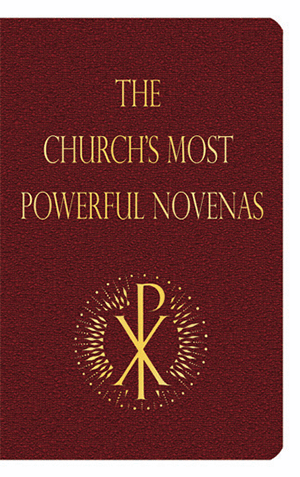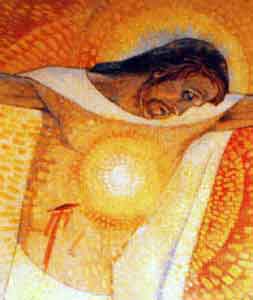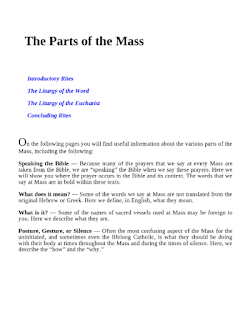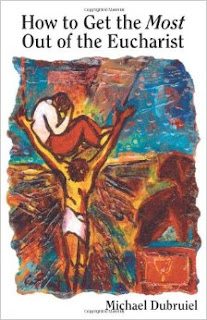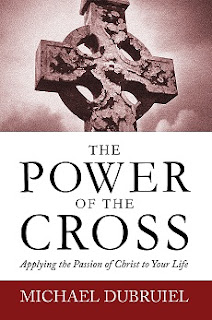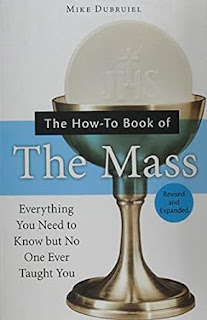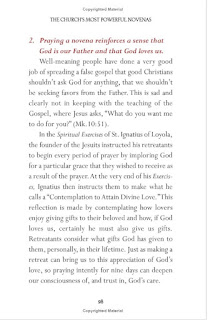Thursday, June 06, 2024
Eucharistic Revival
Wednesday, June 05, 2024
Michael Dubruiel Spiritual Reflections - 1b
This is the second part of step one:
(1) In the first place to love the Lord God with the whole heart, the whole soul, the whole strength...
The map pocket of my car is full of maps. The maps are only helpful to me if I know what my ultimate destination is and if I know where I am at the present moment. Recently while driving in a strange city with the map opened to that city, I knew where I wanted to go but had no idea where I was. Someone in the neighborhood I was in had torn down all of the street signs. I continued to travel up the street until finally I was able to locate a street sign.
Our lives can be the same confused mess that I felt on that day driving aimlessly up and down a city street. Who are we? Why are we here?
The Baltimore Catechism gave us a simple answer. We are here because God loves us. That is the starting point of the spiritual quest is to believe wholeheartedly that we are loved. A subtle but key ingredient to the fear that we feel in surrendering to God is that we do not believe that we are loved but fear that we are hated.
I remember as a child whenever I would be on my way to confession on a Saturday afternoon secretly fearing that God would try to see to it that I was killed before I arrived there. Where this fear came from I do not know, but it was real and it was only much later that I finally realized that God was the redeemer not the enemy.
The attitude we have toward God is all-important if we are to love God with our whole being. We must believe that God loves us first and want what is best for us. It is hard to do anything but love God with our whole being if we believe that God loves us. In an older translation of the New American Bible the words of Jesus are applicable here, “Fear is useless, what is needed is trust.” The words of the supplicant must be our words also, “I believe Lord, help my unbelief.”
It may seem obvious that the first step that anyone would make toward perfect communion with God is to place God at the very center, but how many times we look everywhere else for the way? If we wish to have communion with God we must enter into God’s presence and offer our entire being to God.
Tuesday, June 04, 2024
Michael Dubruiel Spiritual Reflections - 1a
This is the first part of step one:
(1) In the first place to love the Lord God with the whole heart, the whole soul, the whole strength...
Benedict begins what will be a list of simple practices with one that is above all others, the practice of a complete love of God. A love that is one that desires only God, symbolized by the heart; a love that meditates only on God symbolized by the soul; and a love that focuses all of its energy on exhibiting this love of God symbolized by my strength.
If we are honest, this is exactly what we all fear the most, an unconditional surrender of all to God.
I remember when I taught high school theology at a Jesuit School the response that I would always receive from my students whenever I would present to them Saint Ignatius’ First Principle and Foundation which teaches that the purpose of our lives is to know, love and serve God and that everything else is secondary and is here to help us attain that purpose. Most of the Catholic students would become outraged, usually a few non-Catholic students in some cases nonbelievers would say it made perfect sense to them.
The issue of acceptance of this foundational attitude in spirituality is one of trust. Do we trust that God wants what is best for us. In our fears is an agenda that thinks that God will only get in the way of our happiness. Unfortunately it takes a long time for most of us to realize that what we think we want changes almost hourly.
We need direction in our lives. Our lives need to be oriented in some direction. The question is where will we seek that guidance?
Monday, June 03, 2024
Novena to the Sacred Heart
Sunday, June 02, 2024
Corpus Christi - Body and Blood of Christ - June 2
Eucharist means..."thanksgiving"
Michael Dubruiel wrote a book to help people deepen their experience of the Mass. He titled it, How to Get the Most Out of the Eucharist. You can read about it here.
- Serve: Obey the command that Jesus gave to his disciples at the first Eucharist.
- Adore: Put aside anything that seems to rival God in importance.
- Confess: Believe in God’s power to make up for your weaknesses.
- Respond" Answer in gesture, word, and song in unity with the Body of Christ.
- Incline: Listen with your whole being to the Word of God.
- Fast: Bring your appetites and desires to the Eucharist.
- Invite: Open yourself to an encounter with Jesus.
- Commune: Accept the gift of Christ in the Eucharist.
- Evangelize :Take him and share the Lord with others.
Saturday, June 01, 2024
June: Month of the Sacred Heart
The promises of the Sacred Heart of Jesus to Saint Margaret Mary:
1. I will give them all the graces necessary for their state of life.
2. I will give peace in their families.
3. I will console them in all their troubles.
4. I will be their refuge in life and especially in death.
5. I will abundantly bless all their undertakings.
6. Sinners shall find in my Heart the source and infinite ocean of mercy.
7. Tepid souls shall become fervent.
8. Fervent souls shall rise speedily to great perfection.
9. I will bless those places wherein the image of
My Sacred Heart shall be exposed and venerated.
10. I will give to priests the power to touch the most hardened hearts.
11. Persons who propagate this devotion shall
have their names eternally written in my Heart.
12. In the excess of the mercy of my Heart, I promise you that my all powerful love will grant to all those who will receive Communion on the First Fridays, for nine consecutive months, the grace of final repentance: they will not die in my displeasure, nor without receiving the sacraments; and my Heart will be their secure refuge in that last hour.
-Michael Dubruiel
Friday, May 31, 2024
May 31- Feast of the Visitation
May is Mary's month, a month we pay special attention to the rosary. The Visitation is on of the Joyful Mysteries of the Rosary. Check out this small hardbound book by Michael Dubruiel and Amy Welborn, Praying the Rosary. Click on the cover for more information.
The Gospels show that the gaze of Mary varied depending upon the circumstances of life. So it will be with us. Each time we pick up the holy beads to recite the Rosary, our gaze at the mystery of Christ will differ depending on where we find ourselves at that moment.
Thereafter Mary’s gaze, ever filled with adoration and wonder, would never leave him. At times it would be a questioning look, as in the episode of the finding in the Temple: “Son, why have you treated us so?” (Lk 2:48); it would always be a penetrating gaze, one capable of deeply understanding Jesus, even to the point of perceiving his hidden feelings and anticipating his decisions, as at Cana (cf. Jn 2:5). At other times it would be a look of sorrow, especially beneath the Cross, where her vision would still be that of mother giving birth, for Mary not only shared the passion and death of her Son, she also received the new son given to her in the beloved disciple (cf. Jn 19:26-27). On the morning of Easter hers would be a gaze radiant with the joy of the Resurrection, and finally, on the day of Pentecost, a gaze afire with the outpouring of the Spirit (cf. Acts 1:14) [Rosarium Virginis Mariae, no. 10].
As we pray the Rosary, then, we join with Mary in contemplating Christ. With her, we remember Christ, we proclaim Him, we learn from Him, and, most importantly, as we raise our voices in prayer and our hearts in contemplation of the holy mysteries, this “compendium of the Gospel” itself, we are conformed to Him.
Thursday, May 30, 2024
Michael Dubruiel
Since the time of early Christianity, there have been forms
of prayer that use breathing as a cadence for prayer. The Jesus
Prayer and the Rosary, along with various forms of contemplative
prayer, are all variations of this type of prayer. The real prayer
behind all of these methods is the prayer of surrender: “Into
your hands I commend my spirit.” This was the prayer that Jesus
prayed to the Father from the cross.
Though confession alone does not remove the temporal penalty
of sin, healing still is possible by God’s grace. Prayer, reading the
Scripture, giving alms, doing good works all are acts that have
had indulgences attached to them by the Church. By obtaining
an indulgence, the Christian receives healing from the temporal
penalty of even the gravest sins, reducing or eliminating altogether
the time of purification needed in purgatory (CCC 1471).
Ideally, the Christian is motivated to perform these spiritual
exercises not from fear of punishment but out of love for God.
As we read in the preceding passage, St. Paul tells the Ephesians
to offer themselves as a spiritual sacrifice with Christ, who has
paid the debt of our sins. Seeing Christ on the cross and meditating
on his love for us should help us to understand how much
God loves
Wednesday, May 29, 2024
Jesus of Nazareth by Pope Benedict XVI
by Michael Dubruiel...from 2007
I think with the release of this book (which I got yesterday and read straight through) the pope is positioning himself to be the St. Thomas Aquinas of our age. How or why do I say this? Because like St. Thomas who answered the objections to the Faith in his day, this pope is doing the same.
A few months ago someone asked me what book I would recommend that they give to their adult children who no longer practiced the faith, without hesitation I named this book as the one. At the time I had only read some excerpts available online from Germany and Italy. It was an act of faith then, now that I have the book I know that my recommendation was justified.
This is a great book, magisterial (even though the pope doesn't want it thought of in that way). It is not just another book about Jesus, it a revolutionary book about Jesus...in that it recaptures why people have had their lives changed by their belief in Jesus for over 2,000 years.
What makes this book so special? It is like a modern Summa (those who know St. Thomas Aquinas will understand me here) in that it answers modern questions of doubt, skepticism and even inquiry on not only who Jesus is, but why Jesus is the most important person anyone has ever or can ever know.
The pope's methodology is to take a scene from the Bible, like the Lord's baptism and then to draw on that scene from the entire Bible, to show what modern scholarship has done to help us to understand the historical context of the scene, tell us how the early Church fathers interpreted the scene, how would it have been viewed in Judaism (he uses the reflections of a Rabbi when discussing the Sermon on the Mount) and then to give the reader the meaning of this event for them. Along the way he answers questions to the many objections modern people bring to their encounter with Jesus.
As someone who has studied theology for a number of years and been exposed to every screwball theology out there, I found this book to be a corrective lens to refocus and correct my vision of who Jesus is and what following him means. What impresses me (and I'm not easily impressed) is that the Pope takes on the "screwball (my term, not his)" theologies in such a way as to making them seem silly (although he is incredibly charitable in his approach).
This book will have a great effect on renewing the Church and centering it on an image of Christ that is Biblical and credible, erasing years of poor and faulty preaching and teaching.
If you are not Catholic, but a Christian you will love this book too. In fact I predict you will be come a big fan of Joseph Ratzinger and will want to read his many published works to encounter someone rooted in Scripture and conversant with modern attacks on it. If you are a non Christian I think you will find in the book an excellent introduction to what Christians believe about the God-man from Nazareth. To all you parents out there who sent your kids to Catholic schools and now wish they would practice their faith, give them this book and reintroduce them to Jesus of Nazareth.
Tuesday, May 28, 2024
Michael Dubruiel: Pocket Guide to the Mass
Michael Dubruiel's Pocket Guide to the Mass - a sample page.
Walks you through the Mass, explaining the biblical basis of prayers, the meaning behind gestures, and a brief overview of the spirituality that brings Catholics together for Eucharist each week.
Published in 2007, still in print.
An excellent resource for your parish for the Eucharistic Revival year.
More books by Michael Dubruiel
Monday, May 27, 2024
Michael Dubruiel: The Pocket Guide to the Mass
A Pocket Guide to the Mass by Michael Dubruiel: introduction
A great resource for the year of Eucharistic Revival!
Get the most out of the Mass...
A Pocket Guide to the Mass walks you through the biblical basis of prayers, the meaning behind gestures, and a brief overview of the spirituality that brings Catholics together for Eucharist each week.
Reenergize your time at Mass or help those who are new or returning to the Church with this quick and insightful overview. Rediscover the fullness of the Mass today!
Sunday, May 26, 2024
May 26: Solemnity of the Most Holy Trinity
as the LORD had commanded him,
taking along the two stone tablets.
and proclaimed his name, "LORD."
Thus the LORD passed before him and cried out,
"The LORD, the LORD, a merciful and gracious God,
slow to anger and rich in kindness and fidelity."
Moses at once bowed down to the ground in worship.
Then he said, "If I find favor with you, O Lord,
do come along in our company.
This is indeed a stiff-necked people; yet pardon our wickedness and sins,
and receive us as your own.
Saturday, May 25, 2024
Michael Dubruiel Books
Here is Michael Dubruiel's Author Page at Amazon:
This pocket guide is meant to serve as an aid to such a varied group as those who:
- Confess regularly
- Are becoming Catholic
- Are making their First Confession
- Have been away from this sacrament for some time
- Are waiting for a "sign" that God can forgive whatever horrible sin has been committed
You will find:
- Answers to basic questions about Confession
- Help in preparing to make a good Confession by examining your conscience and praying before you celebrate the sacrament
- A walk through the sacrament
- How to use the experience of the Apostle Peter as a model for your own ongoing conversion to Jesus Christ.
Friday, May 24, 2024
How to go to Confession
A Pocket Guide to Confession by Michael Dubruiel:
This pocket guide is meant to serve as an aid to such a varied group as those who:
- Confess regularly
- Are becoming Catholic
- Are making their First Confession
- Have been away from this sacrament for some time
- Are waiting for a "sign" that God can forgive whatever horrible sin has been committed
You will find:
- Answers to basic questions about Confession
- Help in preparing to make a good Confession by examining your conscience and praying before you celebrate the sacrament
- A walk through the sacrament
- How to use the experience of the Apostle Peter as a model for your own ongoing conversion to Jesus Christ.
Thursday, May 23, 2024
Eucharistic Pilgrimage
The Eucharistic Pilgrimage continues:
A pilgrimage is “the simultaneous movement of the feet and the soul”—a journey made both externally and internally. The pilgrim travels to a location of spiritual significance, stepping outside of themselves in order to encounter God in places where he has revealed himself. This action mirrors the interior journey of the pilgrim, who uses this experience to draw closer to Our Lord and seek him more intentionally.
The value of a pilgrimage is not in the distance traveled but in the disposition of our own hearts and the zeal with which we seek God. Many saints have had life-changing experiences while on pilgrimage, and the practice has been a part of Christianity from the beginning.
The Pocket Guide to the Mass by Michael Dubruiel would be a good resource for this time.
A Pocket Guide to the Mass walks you through the biblical basis of prayers, the meaning behind gestures, and a brief overview of the spirituality that brings Catholics together for Eucharist each week.
Reenergize your time at Mass or help those who are new or returning to the Church with this quick and insightful overview. Rediscover the fullness of the Mass today!
Wednesday, May 22, 2024
Eucharistic Pilgrimage Begins
A great book for the Eucharistic Revival and Pilgrimage!
From How to Get the Most Out of the Eucharist by Michael Dubruiel
About Michael Dubruiel
From chapter 2 - Serve. Part 4
WHOSE WAY ARE WE PREPARING?
Every Sunday when I come to the Eucharist and am confronted by the words inscribed in stone over the entrance of my parish church, “Prepare the way of the Lord,” I am reminded that the first sacrifice I must make at this Mass is my own ego, and as I strive to relinquish the need to be in control of what will happen at this Eucharist I ask, “What does my lord bid his servant?” (Joshua 5:14).
We all face the same struggle. Some of you may protest:
• “The ushers don’t make me feel welcome in my church.”
Each of us, if given the opportunity to share what we think is keeping us from getting the most out of the Eucharist, is apt to come up with our own list. Recently I asked this question online and received a deluge of responses. Many were true abuses of the liturgy,and were worthy of being reported to the diocesan bishop, but just as many were not.
When I shared my amazement at the number of responses with my wife,she very keenly mused,“They all feel helpless,like they have no control.” As soon as she said this I realized that this was exactly the same thing I had heard from priests and musicians, the two groups who are most often the target of the congregation’s ire.Priests who come into a new parish and encounter established ways of doing things with which they do not agree and yet are powerless (at least at first) to change and musicians who are hired to provide a parish with beautiful music yet find themselves restrained by parish staff or established practice to playing pieces they feel are less than worthy of the liturgy often express frustration at their lack of control.
This brings home a point that we do not like to admit: None of us is in control, no matter what our function is in the liturgy. Yet we are all tempted to think that if we were in charge we could make it all perfect.
St. Rita of Cascia - May 22
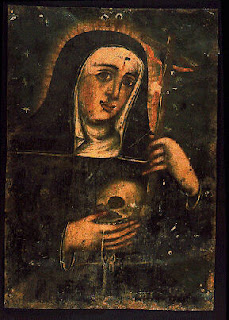 From The Church's Most Powerful Novenas
From The Church's Most Powerful NovenasRita Lotti was born near Cascia in Italy in the fourteenth century, the only child of her parents, Antonio and Amata. Her parents were official peacemakers in a turbulent environment of feuding families.
At an early age Rita felt called to religious life; however, her parents arranged for her to be married to Paolo Mancini. Rita accepted this as God’s will for her, and the newlyweds were soon blessed with two sons.
One day while on his way home, Paolo was killed. Rita’s grief was compounded with the fear that her two sons would seek to avenge their father’s death, as was the custom of the time. She began praying and fasting that God would not allow this to happen. Both sons soon fell ill and died, which Rita saw as an answer to her prayers.
Now alone in the world, Rita sought to enter religious life, feeling that God had cleared the path for her to fulfill the vocation that she had felt was hers from childhood. Yet she found that the convent she so desired to enter was reluctant to accept her due to fears that the political rivals that had killed her husband would bring violence on them.
She finally brought peace between the rivals and was able to enter the Convent of St. Mary Magdalene of the Augustinian Nuns. In religious life, Rita was noted for her holiness. She spent her days not only in prayer and contemplation but also in service to the sick and the poor.
One day while kneeling in prayer and contemplating the passion of Jesus, she received the wound of one thorn from the crown of thorns that she bore until her death some fifteen years later.
Devotion to St. Rita was almost nonexistent for five hundred years, but with her canonization in 1900, all of that has changed. She is truly a saint for every state in life, having spent her life as a married woman, a mother, a widow, and a religious.
Monday, May 20, 2024
Michael Dubruiel: Pentecost Octave
The letter to the Hebrews draws a strong connection
between the cross and prayer. Because every moment of our
earthly existence is threatened by death, and we know neither the
day nor the hour when that existence will come to an end, we,
too, need to cry out to the God who can save us. Like Moses, we
need the help of our fellow Christians to hold up our arms when
they grow tired. We, too, need the help of the Holy Spirit to
make up for what is lacking in our prayer.
-The Power of the Cross by Michael Dubruiel
Sunday, May 19, 2024
Pentecost - a Glorious Mystery
Michael Dubruiel conceived and put together the small hardbound book, Praying the Rosary. Click on the cover for more information.
The Gospels show that the gaze of Mary varied depending upon the circumstances of life. So it will be with us. Each time we pick up the holy beads to recite the Rosary, our gaze at the mystery of Christ will differ depending on where we find ourselves at that moment.
Thereafter Mary’s gaze, ever filled with adoration and wonder, would never leave him. At times it would be a questioning look, as in the episode of the finding in the Temple: “Son, why have you treated us so?” (Lk 2:48); it would always be a penetrating gaze, one capable of deeply understanding Jesus, even to the point of perceiving his hidden feelings and anticipating his decisions, as at Cana (cf. Jn 2:5). At other times it would be a look of sorrow, especially beneath the Cross, where her vision would still be that of mother giving birth, for Mary not only shared the passion and death of her Son, she also received the new son given to her in the beloved disciple (cf. Jn 19:26-27). On the morning of Easter hers would be a gaze radiant with the joy of the Resurrection, and finally, on the day of Pentecost, a gaze afire with the outpouring of the Spirit (cf. Acts 1:14) [Rosarium Virginis Mariae, no. 10].
As we pray the Rosary, then, we join with Mary in contemplating Christ. With her, we remember Christ, we proclaim Him, we learn from Him, and, most importantly, as we raise our voices in prayer and our hearts in contemplation of the holy mysteries, this “compendium of the Gospel” itself, we are conformed to Him.
Saturday, May 18, 2024
Pentecost Vigil
The Mass Readings for the Pentecost Vigil:
On the last and greatest day of the feast,
Jesus stood up and exclaimed,
“Let anyone who thirsts come to me and drink.
As Scripture says:
Rivers of living water will flow from within him who believes in me.”
He said this in reference to the Spirit
that those who came to believe in him were to receive.
There was, of course, no Spirit yet,
because Jesus had not yet been glorified.
Friday, May 17, 2024
Eucharistic Pilgrimage Begins May 17
Today is the first day of the national Eucharistic Pilgrimage:
The National Eucharistic Pilgrimage is a truly unique initiative. This is something NEW—a beautiful fusion of the journey TO Jesus and the journey WITH Jesus. What’s more, it is an adventure that all Catholics can do together, either by interior disposition or physical accompaniment.
This is the birth of something remarkable. Join us as we accompany Jesus in the Eucharist from the north, south, east, and west edges of our country, stopping at many holy sites and churches along the way. Together we will journey with Christ on his way to the 10th National Eucharistic Congress, where he comes to encounter his people anew.
A good resource for deepening one's appreciation of the Eucharist would be The How-To Book of the Mass by Michael Dubruiel:
Maybe you are a recent convert, or perhaps you've attended Mass your whole life, but there are still things that puzzle you, like: when you should genuflect and when you should bow; what the different books used at Mass are and what they contain; the meaning of words like "Amen," "Alleluia," or "Hosanna"; what to do during the sign of peace.
You aren't alone.
The How-to Book of the Mass not only provides the who, what, where, when, and why of the most time-honored traditions of the Catholic Church, but also the how. All in an easy-to-read, easy-to-understand format.
In this complete guide to the celebration of the Eucharist you get:
- Step-by-step guidelines to walk you through the Mass
- Biblical background of the prayers of the Mass
- Insights from the Tradition and teaching of the Church
- Practical aid to overcoming distractions
- Concrete ways to grow in your relationship with Jesus Christ at every Mass
- A handy study guide for individual or group use
Includes 2011 Roman Missal Translation changes.
Thursday, May 16, 2024
Pentecost Novena - Part 3
Now is the time to pray to Pentecost Novena. What is a novena? Why should we pray it?
Here's an explanation from The Church's Most Powerful Novenas by Michael Dubruiel (part 2)
3. Praying a novena teaches us the benefit of praying with others to God. While the Second Vatican Council sought to renew a sense of the communal nature of prayer, some of the more zealous sought to achieve this by erasing one aspect of Catholicism where the sense of communal prayer was already a lived reality: the involvement of the Church Victorious — the saints.
Recently while I was visiting an Eastern Orthodox Church, the beauty and the symbolism of the iconostasis struck me. An iconostasis is a wall of icons (consisting of painted images of God, the Blessed Virgin, and the saints) that separates the sanctuary from the nave of the church. In Orthodox churches the walls are covered with icons as a testament that when we on earth gather in prayer, we do not pray alone, but are joined by all of those who have gone before us and are now in heaven. The next day, while I was at Mass in an inner-city church in Detroit, Michigan, I was struck by the statues of the saints (which, in the post-Vatican II Church, are a rarity) and how much they resembled the iconostasis of the Orthodox Church, except ours were three-dimensional.
Wednesday, May 15, 2024
Pentecost Novena - Part 2
Now is the time to pray to Pentecost Novena. What is a novena? Why should we pray it?
Here's an explanation from The Church's Most Powerful Novenas by Michael Dubruiel (part 2)
2. Praying a novena reinforces a sense that God is our Father and that God loves us. Well-meaning people have done a very good job of spreading a false gospel that good Christians shouldn't ask God for anything, that we shouldn't be seeking favors from the Father. This is sad and clearly not in keeping with the teaching of the Gospel, where Jesus asks, "What do you want me to do for you?" (Mk. 10:51).
In the Spiritual Exercises of St. Ignatius of Loyola, the founder of the Jesuits instructed his retreatants to begin every period of prayer by imploring God for a particular grace that they wished to receive as a result of the prayer. At the very end of his Exercises, Ignatius then instructs them to make what he calls a "Contemplation to Attain Divine Love."
This reflection is made by contemplating how lovers enjoy giving gifts to their beloved and how, if God loves us, certainly he must also give us gifts. Retreatants consider what gifts God has given to them, personally, in their lifetime. Just as making a retreat can bring us to this appreciation of God's love, so praying intently for nine days can deepen our consciousness of, and trust in, God's care.
Tuesday, May 14, 2024
Mary and the Muslims - Fatima
MARY
The Qu'ran, which is the Bible for the Muslims, has many passages concerning the Blessed Virgin. First of all, the Qu'ran believes in her Immaculate Conception, and also in her Virgin Birth. The third chapter of the Qu'ran places the history of Mary's family in a genealogy which goes back through Abraham, Noah, and Adam. When one compares the Qu'ran's description of the birth of Mary with the apocryphal Gospel of the birth of Mary, one is tempted to believe that Mohammed very much depended upon the latter. Both books describe the old age and the definite sterility of the mother of Mary. When, however, she conceives, the mother of Mary is made to say in the Qu'ran: "O Lord, I vow and I consecrate to you what is already within me. Accept it from me."
When Mary is born, the mother says: And I consecrate her with all of her posterity under thy protection, O Lord, against Satan!"
The Qu'ran passes over Joseph in the life of Mary, but the Muslim tradition knows his name and has some familiarity with him. In this tradition, Joseph is made to speak to Mary, who is a virgin. As he inquired how she conceived Jesus without a father, Mary answered:
Do you not know that God, when he created the wheat had no need of seed, and that God by his power made the trees grow without the help of rain? All that God had to do was to say, 'So be it, and it was done.'
The Qu'ran was also verses on the Annunciation, Visitation, and Nativity. Angels are pictured as accompanying the Blessed Mother and saying: "Oh, Mary, God has chosen you and purified you, and elected you above all the women of the earth." In the nineteenth chapter of the Qu'ran there are 41 verses on Jesus and Mary. There is such a strong defense of the virginity of Mary here that the Qu'ran, in the fourth book, attributed the condemnation of the Jews to their monstrous calumny against the Virgin Mary.
FATIMA
Mary, then, is for the Muslims the true Sayyida, or Lady. The only possible serious rival to her in their creed would be Fatima, the daughter of Mohammed himself. But after the death of Fatima, Mohammed wrote: "Thou shalt be the most blessed of all women in Paradise, after Mary." In a variation of the text, Fatima is made to say, "I surpass all the women, except Mary."
This brings us to our second point: namely, why the Blessed Mother, in the 20th century, should have revealed herself in the insignificant little village of Fatima, so that to all future generations she would be known as "Our Lady of Fatima." Since nothing ever happens out of Heaven except with a finesse of all details, I believe that the blessed Virgin chose to be known as "Our Lady of Fatima" as a pledge and a sign of hope to the Muslim people, and as an assurance that they, who show her so much respect, will one day accept her divine Son too.
Evidence to support these views is found in the historical fact that the Muslims occupied Portugal for centuries. At the time when they were finally driven out, the last Muslim chief had a beautiful daughter by the name of Fatima. A Catholic boy fell in love with her, and for him she not only stayed behind when the Muslims left, but even embraced the faith. The young husband was so much in love with her that he changed the name of the town where he lived to Fatima. Thus, the very place where our lady appeared in 1917 bears a historical connection to Fatima, the daughter of Mohammed.
The final evidence of the relationship of Fatima to the Muslims is the enthusiastic reception which the Muslims in Africa, India, and elsewhere gave to the pilgrim statue of Our Lady of Fatima. Muslims attended the church services in honor of our Lady, they allowed religious processions and even prayers before their mosques; and in Mozambique, the Muslims who were unconverted, began to be Christian as soon as the statue of Our Lady of Fatima was erected.
Monday, May 13, 2024
Pentecost Novena - 1
Now is the time to pray to Pentecost Novena. What is a novena? Why should we pray it?
Here's an explanation from The Church's Most Powerful Novenas by Michael Dubruiel
Sunday, May 12, 2024
A Pocket Guide to Confession
For a brief, pointed and helpful guide,


